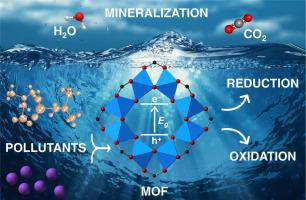Journal of Photochemistry and Photobiology C: Photochemistry Reviews ( IF 13.6 ) Pub Date : 2023-09-13 , DOI: 10.1016/j.jphotochemrev.2023.100635 Pedro H.M. Andrade , Hugo Palhares , Christophe Volkringer , Thierry Loiseau , Matthieu Hureau , Eduardo Nunes , Alain Moissette

|
This review focuses on the many research that have been undertaken in visible-light driven environmental photocatalysis field employing Metal-Organic Framework (MOF) materials for the removal of aqueous pollutants. Correlations between their structural and functional features, and the reactional pathways for pollutant degradation were also addressed, with a particular emphasis on the syntheses and on the charge transfer complexes occurring in the MOF compounds. The extensive possibilities for modifying the properties of MOFs in diverse applications were critical while dealing with a variety of contaminants with different properties. Indeed, because of the infinite number of combinations of different inorganic poly-oxo clusters and organic linkers, and to the possibility of tailoring other variables such as functional groups, pore size, defects, and incorporation of other materials (dyes, semiconductors, metal nanoparticles, covalent organic frameworks, carbon-based materials, magnetic compounds, and inert carriers), MOFs have a high potential to lead the photocatalytic field. Furthermore, the use of mixed methods has shown to be a legitimate and fascinating technique for further developing these systems while considering their strengths and weaknesses. Despite considerable advancements in MOF-based photocatalysts, significant obstacles remain. However, the research of heterogeneous photocatalysis dates back to the 1970 s, but the discussion of MOF materials is even more recent, with just a few decades spent investigating these systems. Nonetheless, tremendous breakthroughs in this area have been made, from structural design to computer simulations, and reports of various MOF materials have constantly increased in the previous several years. As a result, combining the collaborative efforts of researchers from many domains, the future appears to hold promising prospects for MOF-based photocatalysts.
中文翻译:

使用金属有机框架对水污染物进行可见光光催化的最先进技术
本综述重点关注在可见光驱动的环境光催化领域开展的许多研究使用金属有机框架(MOF)材料去除水污染物的领域。还讨论了它们的结构和功能特征以及污染物降解的反应途径之间的相关性,特别强调 MOF 化合物中发生的合成和电荷转移复合物。在处理具有不同性质的各种污染物时,在不同应用中改变 MOF 性质的广泛可能性至关重要。事实上,由于不同的无机多氧簇和有机连接体的组合有无数种,并且可以定制其他变量,例如官能团、孔径、缺陷以及其他材料(染料、半导体、金属纳米粒子、共价有机骨架、碳基材料、磁性化合物和惰性载体),MOFs 具有引领光催化领域的巨大潜力。此外,使用混合方法已被证明是一种合法且令人着迷的技术,可以在考虑这些系统的优点和缺点的同时进一步开发这些系统。尽管基于 MOF 的光催化剂取得了相当大的进步,但仍然存在重大障碍。然而,多相光催化的研究可以追溯到 20 世纪 70 年代,但对 MOF 材料的讨论则更为近期,研究这些系统只花了几十年的时间。尽管如此,从结构设计到计算机模拟,这一领域已经取得了巨大的突破,并且各种MOF材料的报道在过去几年中不断增加。



























 京公网安备 11010802027423号
京公网安备 11010802027423号